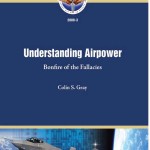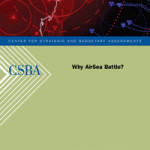Blown Slick Series #6
It is a true statement but not an indictment, that the fleets of the world never had a formal requirement for an airplane, or a submarine, or a communications satellite. Instead, in all cases, a debate was established within the fleet (indeed, within the fleets of the world) and over time, doctrine, technology, people, and organization came to fruition.
Requirements cannot be divorced from detailed understanding of their implementing strategy. In practice, the best requirements come from operators who understand technology in detail and who can, in their mind’s eye, envision the new tactics it makes possible.
Vice Admiral Jerry O. Tuttle
Googling “airpower” will get you nearly 41,600,000 links and Amazon Books near 2000 entries. So prior to getting into more specific topics, this post offers for reader consideration a small handful of books and studies covering multiple aspects of airpower and war in the air that I have found of great interest and use, and indeed to certain different degrees, are references for future articles.
In beginning the Blown Slick Airpower Analysis series, I put forward that the offerings would be presented in a kind of mosaic form as compared to a logical thesis-type “B” follows “A” format. The rationale is that there are so many different things affecting the use of airpower today, that it’s just too difficult, time consuming and non-beneficial and possibly even misleading to create or execute that logic stream. For example discussing the foreseeable threats and geography, such as ISIS and the Middle East as compared to a War-at-Sea scenario in the South China Sea leads to some very divergent requirements, yet we are anticipating the multi-role F-35 to be successful in both. Is that really feasible and what are the long poles in the mission execution tent?
Continuing the link with airpower and the F-35, no matter your take on the aircraft, the technology offered up on multiple fronts – approach to stealth manufacturing, long term maintenance, and the AWACS -like sensor and information manager roles – are certainly new and different tactical concepts for an “F” or fighter designated warplane. One sees very little published here, the media more interested in close-in dogfight “Red Baron” stuff.
That said, I do have a concept of observing and orienting to the whole and will provide my analysis methodology such as it is for critique in the next post. For now, as noted in the opening statement, I offer for reader consideration a small handful of books and studies I have found of great interest. These books will be used as references throughout the remainder of the Blown Slick series and indeed some will form the core of future posts. The short descriptions are from dust jackets, Amazon, Reviews, etc. just to provide some degree of their overall focus. All can be found through either Google or Amazon.
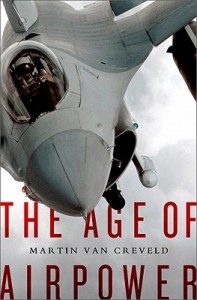 The Age of Airpower by Martin Van Creveld
The Age of Airpower by Martin Van Creveld
A narrative of the rise and fall of the most significant and glamorous offensive and defensive instrument of war in military history—airpower. From the scenes of its greatest exploits during World War I and II, to present day where the advent of ballistic missiles, drones, and other computer-controlled weaponry threaten to eclipse its use all together, van Creveld recounts the successes and failures of airpower to date and suggess how its triumphs could become a thing of the past.
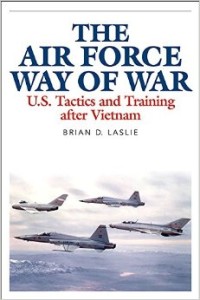 The Air Force Way of War; U.S. Tactics and Training after Vietnam by Brian Laslie
The Air Force Way of War; U.S. Tactics and Training after Vietnam by Brian Laslie
The U.S. Air Force’s poor performance during Vietnam was partly due to the fact that they had trained their pilots according to methods devised during World War II and the Korean War, when strategic bombers attacking targets were expected to take heavy losses. Warfare had changed by the 1960s, but the USAF had not adapted. Between 1972 and 1991, however, the Air Force dramatically changed its doctrines and began to overhaul the way it trained pilots through the introduction of a groundbreaking new training program called “Red Flag.” Laslie examines the revolution in pilot instruction that Red Flag brought about after Vietnam. The program’s new instruction methods were dubbed “realistic” because by the use of well trained aggressor forces they prepared pilots for real-life situations better than simple cockpit simulations or unopposed weapons training missions.
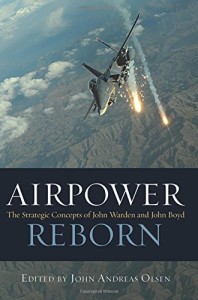 Airpower Reborn; The Strategic Concepts of John Warden and John Boyd Edited by John Andreas Olsen,
Airpower Reborn; The Strategic Concepts of John Warden and John Boyd Edited by John Andreas Olsen,
Col John Boyd is known mostly for his OODA Loop decision making concept, but he also developed the Energy Maneuverability (EM) concepts still in use for aircraft design currently and is considered the “father” of the F-16. He is considered by many a serious strategic thinker based on his work “Patterns of Conflict.” Col John Warden is given considerable credit for the design of the air war for Desert Storm. His strategic targeting concepts of the five rings are offered as the proper way to take down an enemy through airpower. “Airpower Reborn suggests that there is a great need for contemporary airpower thought for current and future air warfare employment. His work is both an anthology of airpower thought and a call to action from the editor. Six world-leading theorists argue that a viable strategy must transcend the purely military sphere, view the adversary as a multi-dimensional system, and pursue systemic paralysis and strategic effects rather than military destruction or attrition.This book is a attempt to spark discussion about airpower theory and strategy. The author suggests that the persistent belief that modern airpower thought rests solely on century-old airpower prophecy says more about our failure as airpower advocates than it does about airpower critics. It is therefore offered as our job to effectively develop and communicate modern strategic airpower thought to our interested brethren. In his opinion we seem to have failed. (My note, this is a re-opening for “airpower can win war on its on” – Kosovo by example, yes no?)
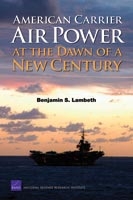 American Carrier Air Power at the Dawn of a New Century by Benjamin S. Lambeth, RAND Corporation
American Carrier Air Power at the Dawn of a New Century by Benjamin S. Lambeth, RAND Corporation
This report presents the highlights of the U.S. Navy’s carrier air performance during the first two major wars of the 21st century —
Operation Enduring Freedom against the Taliban and al Qaeda in
Afghanistan in 2001 and 2002 and the subsequent three-week period of major combat in Operation Iraqi Freedom in early 2003 that finally ended the rule of Saddam Hussein. The report also addresses ongoing modernization trends in U.S. carrier air capability.
With U.S. naval aviation celebration of its 100th anniversary in 2011, carrier air power’s classic roles and missions have not changed greatly from those of the 20th century. Yet the nation’s carrier strike groups are taking on a substantial qualitative improvement in their overall combat leverage with the completion of the Super Hornet acquisition, the advent of the EA-18 and F-35C, along with the prospective introduction of unmanned surveillance and strike aircraft into the Navy’s carrier air-wing.
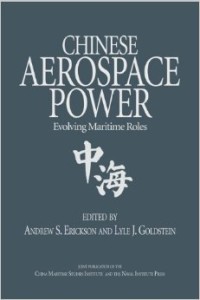 Chinese Aerospace Power: Evolving Maritime Roles
Chinese Aerospace Power: Evolving Maritime Roles
Andrew Erickson (Editor) and Lyle J. Goldstein (Editor)
A comprehensive survey of Chinese aerospace developments, with a focus on areas of potential strategic significance previously unexplored in Western scholarship. The book also links these developments to the vast maritime battlespace of the Asia-Pacific region and highlights the consequent implications for the U.S. military, particularly the U.S. Navy
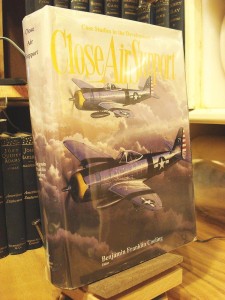 Close Air Support; Case Studies Benjamin F. Cooling (Editor)
Close Air Support; Case Studies Benjamin F. Cooling (Editor)
This multi-author study was tasked by Air Force Director of Plans to prepare multiple case studies on various aspects of air warfare. The Air Force History Program approached some of the foremost historians in the field of military aviation to record their assessments as a resource for planning within the Air Force and the Army for several years to come. Each author was asked to produce an original case study on a defined period or subject. The essays were to be based on all relevant published literature and on the key archival documents containing the record of how various air forces actually developed and applied their systems of close air support to ground combat. Each author was also asked to cover certain basic topics: initial doctrine, organization of forces, background and courses of the air-ground campaigns, communications systems, command and control arrangements, weaponry and technology, and the decisions and people that determined the course of action and shaped its outcome.
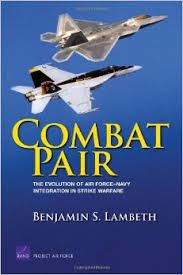 Combat Pair; The Evolution of Air Force-Navy Integration in Strike warfare by Benjamin S. Lambeth, RAND Corporation
Combat Pair; The Evolution of Air Force-Navy Integration in Strike warfare by Benjamin S. Lambeth, RAND Corporation
This report documents the cross-service harmony that the U.S. Air Force and U.S. Navy have steadily developed in their conduct of integrated strike operations since the first Persian Gulf War in 1991. That close harmony contrasts sharply with the situation that prevailed throughout most of the Cold War, when the two services maintained separate and unique operating mindsets and lacked any significant interoperability features.
 Destined for Glory; Dive Bombing, Midway, and the Evolution of Carrier Airpower byThomas Wildenberg
Destined for Glory; Dive Bombing, Midway, and the Evolution of Carrier Airpower byThomas Wildenberg
On 4 June 1942, three squadrons of U.S. Navy Dauntless dive bombers destroyed Japan’s carrier force at Midway and changed the course of the Pacific war. The key ingredient to the Navy’s success was the planning and training devoted to the tactic of dive bombing. Examining how political, economic, technical, and operational factors influenced the development of carrier airpower between 1925 and 1942, he shows why dive bombing became the Navy’s weapon of choice. He also pays tribute to the select group of naval aviators who drove the evolution of carrier tactics. Although many books have been written about the Battle of Midway, this is the first to focus on how the Navy came to develop the one aerial weapon that proved to be the decisive instrument of victory
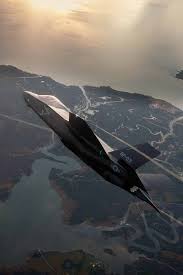 “Re-Norming” Air Operations
“Re-Norming” Air Operations
Multiple authors from Second Line of Defense
The historical pattern of U.S. air dominance is not the practical reality of today’s escalating and sophisticated adversarial air challenge. To move forward, one needs to recognize that the new combat aircraft are not simply an iteration of change but a potential driver for new paradigms of combat operations, in the air, at sea, and in air-ground concepts of operation. The old system of sequential air operations built around legacy aircraft, AWACS, and multiple assets needs to be replaced in a timely manner by a well-resourced distributed operations enterprise.
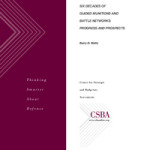 Six Decades of Guided Munitions and Battle Networks; Progress and Prospects by Barry D. Watts, Center for Strategic and Budgetary Assessments (CSBA)
Six Decades of Guided Munitions and Battle Networks; Progress and Prospects by Barry D. Watts, Center for Strategic and Budgetary Assessments (CSBA)
This report has two basic aims: (1) to assess the influence terminally guided, non-nuclear (or “conventional”) munitions have exerted on the conduct of warfare since their initial use during World War II; and (2) to anticipate the influence further advances in conventional guided munitions are likely to have on military operations in coming decades. The heart of this report consists of historical case studies that span a wide variety of the guided munitions developed since the beginning of the Second World War by various war-fighting communities and military services, predominately American ones. A principal aim is ultimately to suggest how further advances in guided munitions may affect the future conduct of military operations, a detailed understanding is needed of the actual changes in tactics, doctrines, operational concepts, military organizations, and combat outcomes these weapons have caused to date, and why.
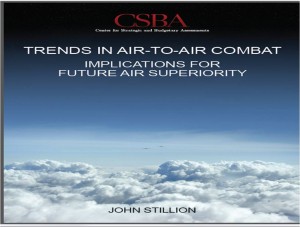 Trends in Air-Air Combat; Implications for Future Air Superiority by John Stillion, CSBA
Trends in Air-Air Combat; Implications for Future Air Superiority by John Stillion, CSBA
A historical analysis of trends in air-to-air combat, evaluating air combat operations over the past century. The goal of this study was to assess how advances in sensor, weapon, and communication technologies have changed air combat and the implication of these trends for future combat aircraft designs and operational concepts. The conclusion of this study was that over the past few decades, advances in electronic sensors, communications technology, and guided weapons may have fundamentally transformed the nature of air combat. The trends suggest it may be appropriate to cast a much wider net in the development of future air combat operational concepts, sensors,weapons, and platforms, which would include examining “radical” departures from traditional fighter concepts that rely on enhanced sensor performance, signature control, networks to achieve superior SA, and very-long-range weapons to complete engagements before being detected or tracked by enemy aircraft.
Understanding Airpower; Bonfire of the Fallacies by Colin s. Gray
The general purpose of this monograph is to help prevent or
reduce error in debates over all aspects of airpower. Since we
humans, our institutions and procedures, and our behavior
are friction prone and apt to err, it is sensible to try to diminish the pile of assumptions, beliefs, attitudes, and opinions that are plainly wrong. This study examines and exposes nine fallacies such as 2) Airpower is an inherently strategic instrument; 3) The development of airpower is driven by technology not ideas; 4) Airpower is about targeting; and 9) The twenty-first century is the missile, space, and cyberspace age(s); airpower is one of yesterday’s revolutions.
Why AirSea Battle by Andrew F. Krepinevich, CSBA
operational concept called AirSea Battle which appears designed to assess how US power-projection. TCurrently there is little indication that China or Iran intend to alter their efforts to create “no-go zones” in the maritime areas off their coasts. The United States is thus confronted
with a strategic choice: to risk a loss of military access to areas vital to its security or to explore options for preserving access. The paper describes how China and Iran are engaged in military modernization efforts whose principal purpose appears to be to deny the United States the ability to sustain military forces in two areas of vital interest, the Western Pacific and the Persian Gulf, respectively. Recently the United States Air Force and Navy agreed to address the issue. Both Service chiefs are committed to pursuing a new his paper argues that an Air Force-Navy AirSea Battle concept is needed. It begins by noting the critical role that power projection operations have played in providing for the United States’ security since becoming an active global power nearly seventy years ago.
********************************************************
Final notes: Operational threads within the above books/studies will run through many of the upcoming posts. Some of these will be addressed individually as quasi book reviews as fitting within the mosaic as the author’s thoughts fit or contrast with my own. I begin here a convention of using blue print as a heads up on future articles. The airwar in Vietnam continues to bring on discussion particularly in regard to the use or lack of guns in the air-air context. In addition, it provides food for thought on the multi-role fast movers. For further references on the airwar in Vietnam see the earlier post Year of War – Reflection from the ’72 WestPac cruise stories.
Next: Discussion of the tools for providing perspective on future airpower.


